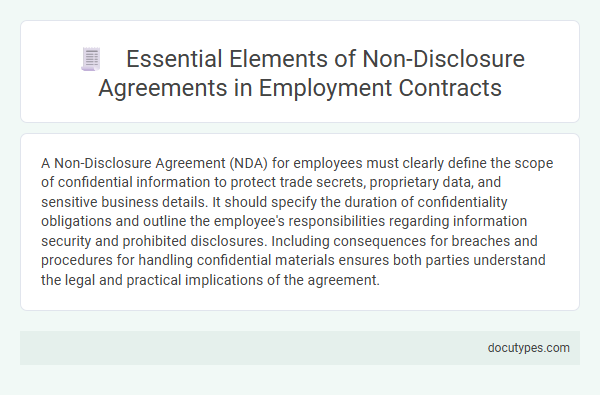A Non-Disclosure Agreement (NDA) for employees must clearly define the scope of confidential information to protect trade secrets, proprietary data, and sensitive business details. It should specify the duration of confidentiality obligations and outline the employee's responsibilities regarding information security and prohibited disclosures. Including consequences for breaches and procedures for handling confidential materials ensures both parties understand the legal and practical implications of the agreement.
Definition and Purpose of Non-Disclosure Agreements
A Non-Disclosure Agreement (NDA) is a legal contract designed to protect sensitive information by restricting its disclosure. It defines what information must remain confidential and outlines the obligations of the employee.
The purpose of an NDA is to safeguard proprietary data, trade secrets, and business strategies from being shared with unauthorized parties. This agreement ensures that your employer's valuable information remains secure during and after your employment. Understanding these terms helps maintain trust and legal compliance in the workplace.
Key Parties Involved in Employment NDAs
A Non-Disclosure Agreement (NDA) in employment protects confidential information shared between the employer and employee. Understanding the key parties involved ensures clarity in responsibilities and legal protections.
- Employer - The party that owns the confidential information and seeks to protect business secrets.
- Employee - The individual required to maintain confidentiality and avoid disclosing sensitive company data.
- Third Parties - External entities sometimes included in the agreement to cover contractors or consultants with access to proprietary information.
Identifying these key parties is critical for drafting effective NDAs that safeguard a company's intellectual property and trade secrets.
Scope of Confidential Information Covered
The scope of confidential information covered in a Non-Disclosure Agreement (NDA) for employees defines the specific types of data and knowledge protected under the agreement. This section ensures both parties clearly understand what information must remain private, including trade secrets, business strategies, client lists, and proprietary technology.
Precise definitions within the scope prevent ambiguity and reduce the risk of unintentional disclosures. Limiting the scope to relevant information aligns with legal standards and supports enforceability in case of disputes.
Duration of Confidentiality Obligations
The duration of confidentiality obligations in a Non-Disclosure Agreement (NDA) defines how long employees must protect sensitive information. Understanding this timeframe is crucial for ensuring compliance even after Your employment ends.
This period often extends beyond the term of employment to safeguard trade secrets and proprietary data.
- Start Date of Obligation - Specifies when the confidentiality duties begin, typically upon signing the NDA or starting employment.
- Length of Confidentiality Period - Defines the exact time frame, which can range from several years to indefinitely, depending on the sensitivity of the information.
- Survival Clause - Explains that confidentiality obligations continue even after Your termination or resignation, maintaining protection of company secrets.
Employee Responsibilities and Limitations
Employee responsibilities in a Non-Disclosure Agreement (NDA) include safeguarding confidential company information and refraining from unauthorized disclosure. Employees must understand the scope of sensitive data covered, such as trade secrets, proprietary processes, and client details.
Limitations specified in an NDA often restrict employees from sharing information during and after employment, including post-termination periods. These limitations ensure company assets remain protected and prevent competitive disadvantages caused by information leaks.
Exclusions from Non-Disclosure Provisions
| Key Information | Description |
|---|---|
| Definition of Confidential Information | Clearly outlines what constitutes confidential information to differentiate protected data from non-sensitive information. |
| Exclusions from Confidential Information | Specifies categories of information not covered, such as publicly known data, information independently developed by the employee, and information disclosed legally by third parties. |
| Public Domain Exclusion | Information already available in the public domain before disclosure is excluded from protection. |
| Independent Development | Data or knowledge the employee develops independently, without reference to confidential materials, is excluded. |
| Legally Required Disclosure | Allows employees to disclose information if required by law, regulation, or court order without breaching the agreement. |
| Employee's Prior Knowledge | Information that the employee can prove was known prior to the employment or agreement date. |
| Proper Documentation | Non-disclosure agreements must document exclusions explicitly to prevent ambiguity and potential legal disputes. |
| Scope and Duration | Defines the extent and length of the confidentiality obligations, ensuring exclusions are honored over time. |
Consequences of Breaching the NDA
Breaching a Non-Disclosure Agreement (NDA) can lead to severe legal consequences for employees, including lawsuits and financial penalties. Employers may seek injunctions to prevent further disclosures and claim damages for any losses incurred. Confidentiality violations can also result in termination of employment and damage to the employee's professional reputation.
Legal Remedies and Enforcement
Non-disclosure agreements (NDAs) protect sensitive company information by legally binding employees to confidentiality. Understanding the legal remedies and enforcement mechanisms in NDAs is critical to ensuring compliance and protecting business interests.
- Injunctive Relief - Courts can order employees to immediately stop disclosing confidential information to prevent further damage.
- Monetary Damages - Employees may be required to compensate the company for any financial losses resulting from a breach of the NDA.
- Legal Enforcement Procedures - NDAs specify the jurisdiction and methods for dispute resolution, ensuring clear processes for enforcing agreements.
Integration with Other Employment Contract Clauses
What information is critical in a Non-Disclosure Agreement for employees regarding integration with other employment contract clauses? Clear definitions of confidential information and obligations must align with existing contract terms to avoid conflicts. Consistency between the NDA and clauses on intellectual property, non-compete, and termination ensures enforceability and protects both parties.
What Information Is Critical in a Non-Disclosure Agreement for Employees? Infographic

